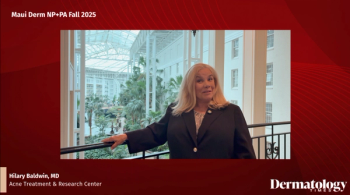
- Dermatology Times, September 2020 (Vol. 41, No. 9)
- Volume 41
- Issue 9
Phenotypes inform management options
Many patients with rosacea have features that overlap more than one subtype of the condition. A recent publication serves as a compliment to the classification guide with the intention of guiding treatment and management options based on individual patient features.
Review supports a comprehensive approach to patient care
Insights into the pathogenesis and pathology of rosacea have established the condition as having varying subtypes. However, many patients with rosacea have features that overlap more than one subtype, experts say. Tailoring treatment options based on individual patient features is ideal to optimize outcomes, one expert says in context of an updated report on the available management options.
An article published in the Journal of the American Academy of Dermatology and developed by members of the National Rosacea Society (NRS) Expert Committee presents a review of treatment options (available at the time of the review), including summary tables that categorize modalities based on features they target.1 The updated management options represent the companion to the
RELATED:
The NRS Expert Committee was comprised of a multidisciplinary panel of 27 members providing expertise in dermatology, laser therapy, skincare, and ophthalmology. The committee believes that categorizing treatment modalities and presenting them according to the features they target will facilitate treatment selections that address the specific needs of individual patients, Dr. Thiboutot tells Dermatology Times.
“In the interest of considering the broad spectrum of potential therapies for rosacea, we made the best effort to have representation from a variety of dermatology specialists and ophthalmologists recognized for their knowledge in medical, procedural, and aesthetic dermatology and in the care of the ocular symptoms of rosacea,” Dr. Thiboutot says.
The development process began with a review of the relevant literature. The committee then convened to discuss the evidence and the efficacy of the therapies based on the available literature and clinical experience. In creating the report, the committee’s intention was to present the management options as a menu of choices rather than as a tiered protocol or algorithmic approach.
RELATED:
“Because the phenotypes of rosacea are so varied and there are nuances with regard to patient preferences for treatment, the committee members believed that listing treatment options and ratings of their evidence base would best afford clinicians the flexibility to tailor a regimen to an individual patient,” Dr. Thiboutot says.
The narrative portion of the article presents overviews of medications, light devices, and treatments for ocular rosacea as well as for lifestyle management and skincare. Three separate tables list treatment options for diagnostic features (ie, persistent erythema and phymas), major features (ie., papules/pustules, telangiectasia, and flushing), and ocular rosacea. Relative efficacy ratings for the various management options are reported graphically using a system of circles, which can range in number from one (least effective) to four (most effective). Filled versus open circles are used to indicate whether the strength of the evidence base for rating relative efficacy was considered strong versus weak.
The report also points out that prior to selecting treatment, it is important that clinicians understand which features of rosacea are the most bothersome to the patient because the information may be important for deciding on the level of therapy. It is noted that although patients’ perceptions of their facial appearance and its impact on their lives can vary, survey findings indicate that regardless of rosacea severity, patients may suffer substantial negative psychosocial sequelae.
“As mentioned in the management recommendations, clearing of inflammatory lesions may be appropriate and is often feasible. However, patients with concerns about erythema may need to be advised that complete elimination of facial coloration can result in an undesirable sallow appearance,” Dr. Thibotout says.
Revision anticipated
The NRS Expert Committee notes that the recommended management options are considered provisional and may need to be updated pending new information and the emergence of new therapies.
“Since this project was completed, additional therapies have been approved for use in rosacea that were not available for evaluation at the time,” Dr. Thiboutot says.
References
1 Thiboutot D, et al. J Am Acad Dermatol. 2020;82(6):1501-1510.
2 Gallo RL, et al. J Am Acad Dermatol. 2018;78(1):148-155.
Articles in this issue
over 5 years ago
Will OSHA cite me for requesting employees not wear masks?over 5 years ago
How safe are cosmetics?over 5 years ago
Pretreatment punch technique guides safe injectionover 5 years ago
What we know (and don’t) about dietary effects on skin agingover 5 years ago
Microbiome-based treatments not ready for prime timeover 5 years ago
Emerging options for high-risk melanomaover 5 years ago
AI has potential to improve melanoma detectionover 5 years ago
Autoantigen array identifies IgG4 anti-gliadin autoantibodyNewsletter
Like what you’re reading? Subscribe to Dermatology Times for weekly updates on therapies, innovations, and real-world practice tips.


















